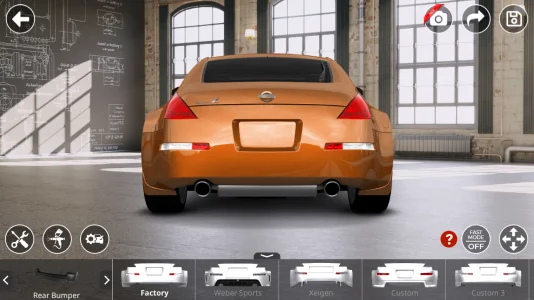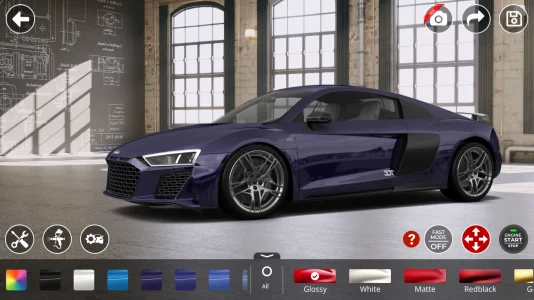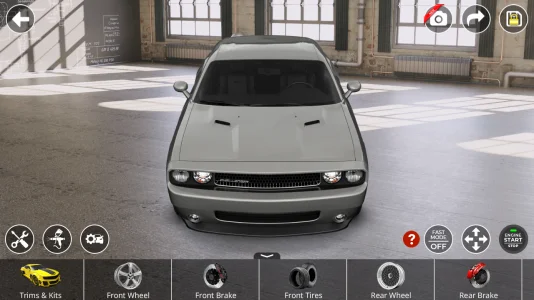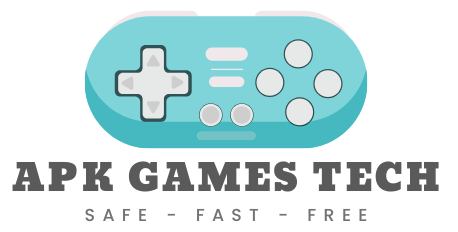Download 3DTuning MOD Free APK
*3DTuning*, developed by 3DTUNING LLC, is a simulation game that functions as a sophisticated 3D vehicle configurator. Its core concept provides a digital sandbox where users can customize hundreds of real-world cars, trucks, and motorcycles. Players use an exhaustive catalog of aftermarket parts to create unique vehicle builds, which can then be saved and shared within the game’s integrated social platform for automotive enthusiasts.
Screenshot Gallery



What is 3DTuning?
An Introduction to the 3DTuning Digital Experience
3DTuning: Car Game & Simulator represents a unique entity within the mobile application landscape, functioning less as a traditional game and more as a sophisticated, photorealistic 3D vehicle configurator. Developed and published by 3DTUNING LLC, this application provides automotive enthusiasts with an expansive digital sandbox for creative expression. The core concept allows users to select from hundreds of real-world vehicles and modify them with an exhaustive catalogue of parts, serving as both a design tool and a social platform for the global car community. Its initial release on December 29, 2014, established a long-standing presence in a niche that blends simulation, racing, and casual genres. The application's robust cross-platform architecture ensures a persistent user experience, syncing a personal "Garage" of creations between Android, iOS, and PC (via emulator) or macOS devices featuring Apple's M1 chip or later.Core Gameplay: The Digital Design Simulator
The primary user engagement in 3DTuning is centered on the act of creation rather than conventional game mechanics like racing or skill-based challenges. The gameplay loop is a pure design simulation, where the user journey progresses from selecting a stock vehicle to curating a fully customized showpiece. This focus on static creation makes 3DTuning a powerful tool for visual expression, allowing users to plan real-world projects or simply experiment with automotive design concepts without the pressure of competitive objectives.The Configurator Interface and Mechanics
Upon selecting a base vehicle from a vast library spanning makes, models, and eras, the user enters the main configurator view. This 3D environment provides complete rotational, pan, and zoom controls for detailed inspection. The modification process is logically organized through a primary interface that facilitates deep customization. Key functionalities include adjusting the vehicle's stance by modifying suspension height, camber, and wheel offset. Users can apply various shades of window tint, and for select high-definition models, interactive elements such as toggling headlights or listening to pre-recorded engine sounds add a layer of immersive detail. Preserving these creations requires a registered account, which enables access to a cloud-synced Garage that is accessible across all supported platforms.An Expansive Catalogue of Vehicles and Parts
The foundational asset of the 3DTuning platform is its immense and continuously expanding digital inventory. The vehicle library is extensive, featuring a globally diverse collection of cars, trucks, and motorcycles from the early 20th century to the present day. This includes legendary Japanese Domestic Market (JDM) vehicles, classic American muscle cars, European sports sedans, and heavy semi-trucks. Supporting this vehicle collection is a staggering inventory of tens of thousands of individual components. The level of detail allows for a granular approach to customization, enhanced by the inclusion of numerous real-world aftermarket brands. This feature blurs the line between a virtual configurator and a practical shopping tool, as an integrated on-line auto parts catalogue can provide item specifications and vendor information. The range of available modifications includes:- Body Modifications: A wide selection of front and rear bumpers, side skirts, hoods, spoilers, fenders, and comprehensive wide body-kits.
- Wheels and Tires: A massive collection of rims in various styles, which can be paired with both street performance and aggressive off-road tires.
- Lighting Systems: An array of custom headlight and taillight assemblies to alter the vehicle's visual signature.
- Accessories: A deep catalogue of smaller components such as grilles, side mirrors, decals, roof racks, bull bars, and bed liners for trucks.
Game Modes and the Social Ecosystem
While the core experience can be a solitary creative act, 3DTuning’s long-term engagement is driven by a well-integrated social and competitive ecosystem. These features transform the application from a static tool into a dynamic community platform where users showcase their work, compete for recognition, and draw inspiration from a global user base.The Challenge Arena
The primary game-like element within 3DTuning is its "Challenge" system. These are themed design competitions with a limited duration, prompting users to create a build for a specific vehicle model or adhere to a particular style, such as "Off-Road" or "JDM." Submissions are judged entirely by the community through a voting system where users are presented with pairs of designs and select their preference. Builds that accumulate the most positive votes ascend the challenge leaderboard. Success is incentivized through a reward system where players earn "Diamonds," the in-game virtual currency, for participation and high placement.A Social Hub for Automotive Tuners
Beyond direct competition, 3DTuning is structured as a social network. Every registered user possesses a public "Garage" that functions as a personal gallery of their saved creations. A "Timeline" feature operates like a social media feed, allowing users to post finished builds for the community to view, "Like," and comment on. This fosters a vibrant, self-perpetuating cycle of user-generated content and inspiration. The platform also incorporates basic social networking tools, including friend requests and private messaging, to facilitate more direct community interaction. This continuous loop of creation, competition, and community validation is the primary mechanism for long-term user retention.Monetization Model and Technical Profile
3DTuning operates on a free-to-play model, generating revenue through a combination of in-app advertising and optional in-app purchases (IAPs). The application can be downloaded and used without initial cost, with a clear path to unlock all content through gameplay. However, the platform's technical execution has been a source of persistent user friction.In-Game Economy and Purchases
Users can spend real money to acquire vehicle packs or purchase an ad-free experience. The in-game economy is centered on the premium virtual currency, "Diamonds," which can be purchased directly or earned for free. The free-to-unlock path is facilitated through daily login rewards, watching rewarded video ads, gaining experience levels, and competing in community challenges. This economic structure requires consistent daily engagement to progress without payment. Unfortunately, user reports document significant issues with the IAP system, including purchased content failing to unlock and paid ad-free status ceasing to function, which has eroded user trust in the platform's transaction system.Performance, Stability, and Security
Despite its ambitious scope, the application's technical foundation exhibits considerable strain. User feedback across all platforms consistently highlights performance issues, including frequent application crashes, visual glitches, and an unresponsive user interface. The developer has acknowledged that the application is resource-intensive and may not perform well on older or lower-specification hardware, particularly devices with 3GB of RAM or less. More critically, the developer's data safety disclosure on the Google Play Store raises significant security concerns. It confirms the collection of personal user data while explicitly stating that this "Data isn't encrypted." In the modern software environment, the absence of data encryption represents a severe security vulnerability, leaving user information potentially exposed.Android APK Installation and Advisory
For Android users, the application is officially distributed through the Google Play Store. An alternative method is installing the app via an Android Application Package (APK) file, a process known as sideloading. While this method can provide access to older versions of the app, it carries substantial risks. Unofficial APK sources do not undergo the security scanning provided by Google Play Protect, meaning the files can be tampered with to include malware, spyware, or adware. It is also important to note that 3DTuning has different builds tailored to specific CPU architectures (e.g., armeabi-v7a for older 32-bit devices, arm64-v8a for modern 64-bit devices). Installing the incorrect APK for a device's architecture can lead to instability and poor performance. Therefore, it is strongly recommended that all users install 3DTuning exclusively from the official Google Play Store to guarantee file authenticity and security.An Analytical Guide to the 3DTuning Vehicle Configurator
3DTuning presents a unique simulation experience centered on automotive design and customization. The application functions as a sophisticated, photorealistic 3D vehicle configurator, providing players with a digital sandbox for creative expression. Its core gameplay loop eschews traditional racing mechanics in favor of an in-depth modification system. Players engage with a vast catalog of real-world vehicles and aftermarket parts to design, build, and share their ideal automotive creations within a global community of enthusiasts.
The Core Gameplay Loop: From Stock to Showpiece
The primary player activity in 3DTuning involves the selection and systematic modification of virtual vehicles. The game rewards creative design and attention to detail, with progression tied to community engagement rather than skill-based driving challenges. The entire experience is built around the central configurator interface, a powerful tool for visual creation.
Vehicle Selection and the Workshop
A player’s journey begins with the selection of a base vehicle. The platform offers an extensive library containing over 300 highly detailed models, including cars, trucks, and motorcycles from various manufacturers and historical eras. Players can filter this collection by type, make, or model year to locate a specific chassis. Once selected, the vehicle loads into the main 3D workshop, where the user can manipulate the camera to rotate, pan, and zoom for detailed inspection from any angle.
The Customization Interface
The workshop interface organizes all modification tools into three primary functional tabs. This logical structure streamlines the creative process. The player interacts with these tabs to alter every aspect of the vehicle’s exterior appearance. The “Parts” tab is the heart of the configurator. It opens cascading menus that contain tens of thousands of individual components. Players can swap stock parts for aftermarket alternatives, including front and rear bumpers, hoods, spoilers, wide body-kits, headlights, grilles, and exhaust tips. The wheel and tire selection is particularly robust, featuring a massive collection of rims and performance-specific tires.
The “Colors” tab facilitates aesthetic customization. This system allows the player to apply a new paint job to the vehicle’s body. Users can choose from a standard color palette or utilize a custom color selector for precise hue adjustments. This functionality also extends to individual components, enabling complex, multi-toned design schemes. The “Settings” tab controls more subtle vehicle adjustments. Its key features affect the vehicle’s stance. Players can modify the suspension level to control ride height and adjust wheel camber and offset. This menu also permits the application of window tint with varying levels of darkness. For certain high-definition models, this section contains toggles for interactive elements like activating headlights or listening to pre-recorded engine sounds.
Managing and Saving Creations
Players must register for an account to preserve their design work. A registered user can save a completed build to a personal, cloud-synced “Garage.” This feature provides a persistent collection of the user’s creations. The system’s integration with the main 3DTuning.com website ensures that the player’s Garage is accessible across multiple platforms, including mobile devices and PCs.
Competitive and Social Systems
While the core act of tuning is a solitary creative exercise, 3DTuning integrates social and competitive features to drive long-term engagement. These systems transform the application from a static tool into a dynamic community hub where players showcase their work, compete for recognition, and find inspiration.
The Challenge Arena
The primary game mode is the “Challenge” system. Challenges are themed design competitions that run for a limited time. A challenge prompt may require users to modify a specific car model or adhere to a particular aesthetic style, such as “JDM” or “Off-Road.” Players create a vehicle that meets the theme’s criteria and submit it to the competition. The community handles the judging process through a direct voting system. During the voting period, users are presented with pairs of submissions and select their preferred design. Submissions that receive the most votes ascend the challenge leaderboard. Success in these challenges provides players with the in-game virtual currency, “Diamonds.”
The Social Ecosystem
3DTuning functions as a social network for automotive enthusiasts. Each registered user possesses a public “Garage” that serves as a personal gallery of their saved builds. A “Timeline” feature acts as a social media feed where users can post their finished projects for the community to view. Other users can interact with these posts by leaving “Likes” and comments, which provides feedback and fosters community interaction. This system creates a self-perpetuating cycle of user-generated content and inspiration. Players can also use friend requests and private messaging for more direct communication.
Strategy Guide for Aspiring Tuners
New players can maximize their experience and progression by adopting several key strategies. Efficiently navigating the in-game economy and being mindful of the application’s technical characteristics are crucial for a smooth and rewarding creative process. The following tips provide a roadmap for success.
- Participate in Challenges for Progression: The most efficient method for earning the “Diamonds” needed to unlock vehicle packs is active participation in community Challenges. Competing frequently provides a steady stream of the premium currency, facilitating the free-to-play progression path without requiring real-money purchases.
- Save Your Work Frequently: The application has a documented history of performance instability and unexpected crashes. To prevent the loss of unsaved progress, players should save their builds to the Garage multiple times during a single session. Saving after each major component change is a highly recommended practice.
- Leverage the Website for Stability: If the mobile application performs poorly on a specific device, using the browser-based version on a PC often provides a more stable and responsive experience. Because the user’s Garage syncs across platforms, players can switch between the mobile app and the website without losing any saved work.
- Follow a Structured Build Process: For a first build, players should focus on three high-impact areas to learn the interface. First, navigate to “Parts” and select a new set of wheels. Second, use the “Colors” tab to apply a new paint job. Third, visit the “Settings” tab to lower the vehicle’s suspension for a more aggressive stance. Mastering these basics forms a strong foundation for more complex projects.
The Vehicle and Parts Catalogue
The foundational asset of 3DTuning is its immense inventory of 3D models. The platform’s core appeal derives directly from the depth and authenticity of its digital library of vehicles and components.
Vehicle Library and Content Updates
The vehicle library spans over a century of automotive history, featuring classic cars, modern supercars, JDM legends, American muscle cars, trucks, and motorcycles. The developer maintains a rapid pace of content delivery, adding new cars and parts frequently. A “SCHEDULE” feature within the application allows the community to vote on which new vehicle models should be added next, giving players direct influence over the platform’s development.
The Parts Inventory
A massive catalog of tens of thousands of individual parts supports the vehicle library. This inventory covers nearly all exterior modifications, including a deep selection of bumpers, side skirts, fenders, and full wide body-kits. A key feature that enhances realism is the inclusion of numerous real-world aftermarket brands. Players can equip their virtual cars with components from recognized manufacturers, and an integrated online auto parts catalogue can provide item specifications and vendor information, connecting the virtual experience to real-world products.
